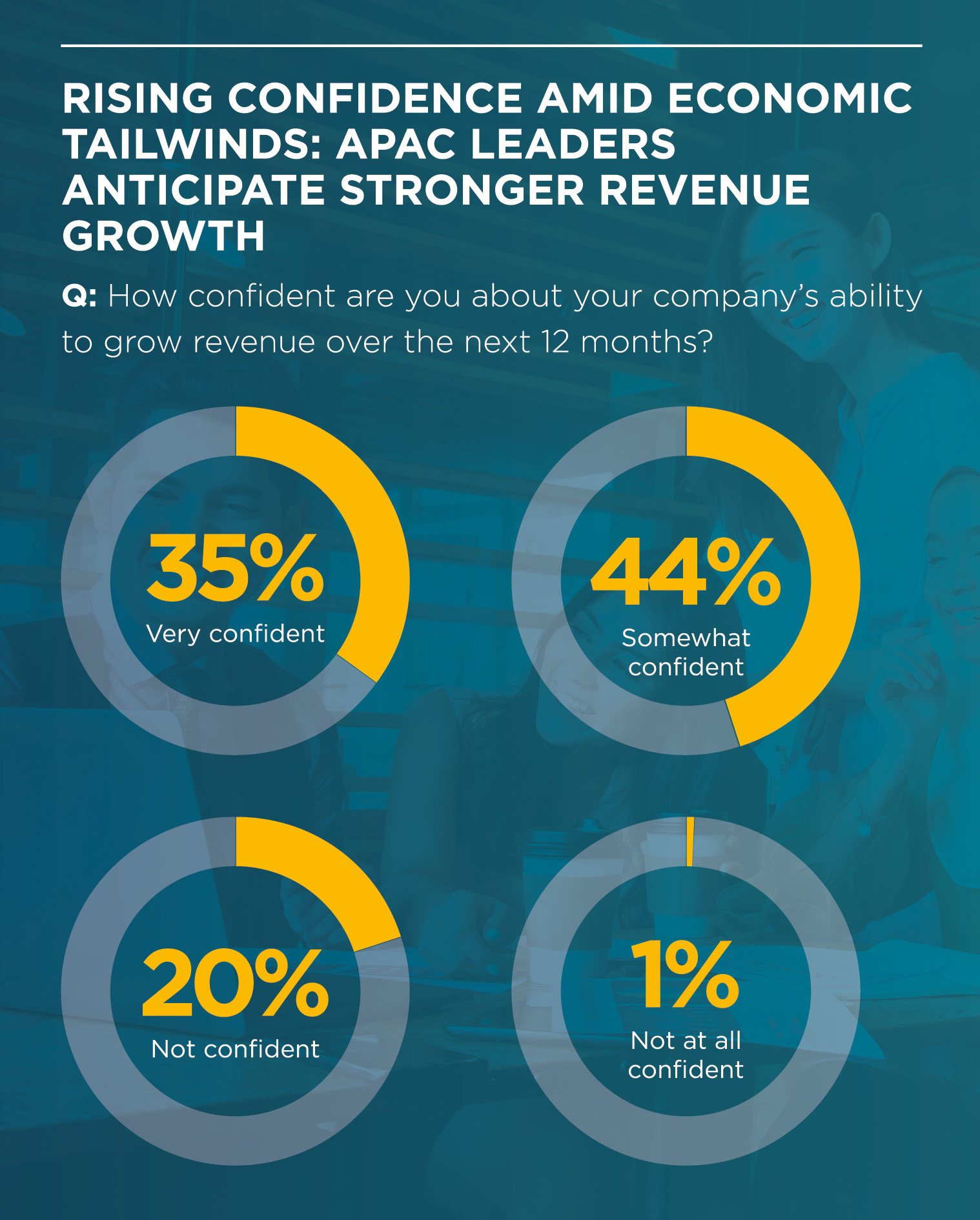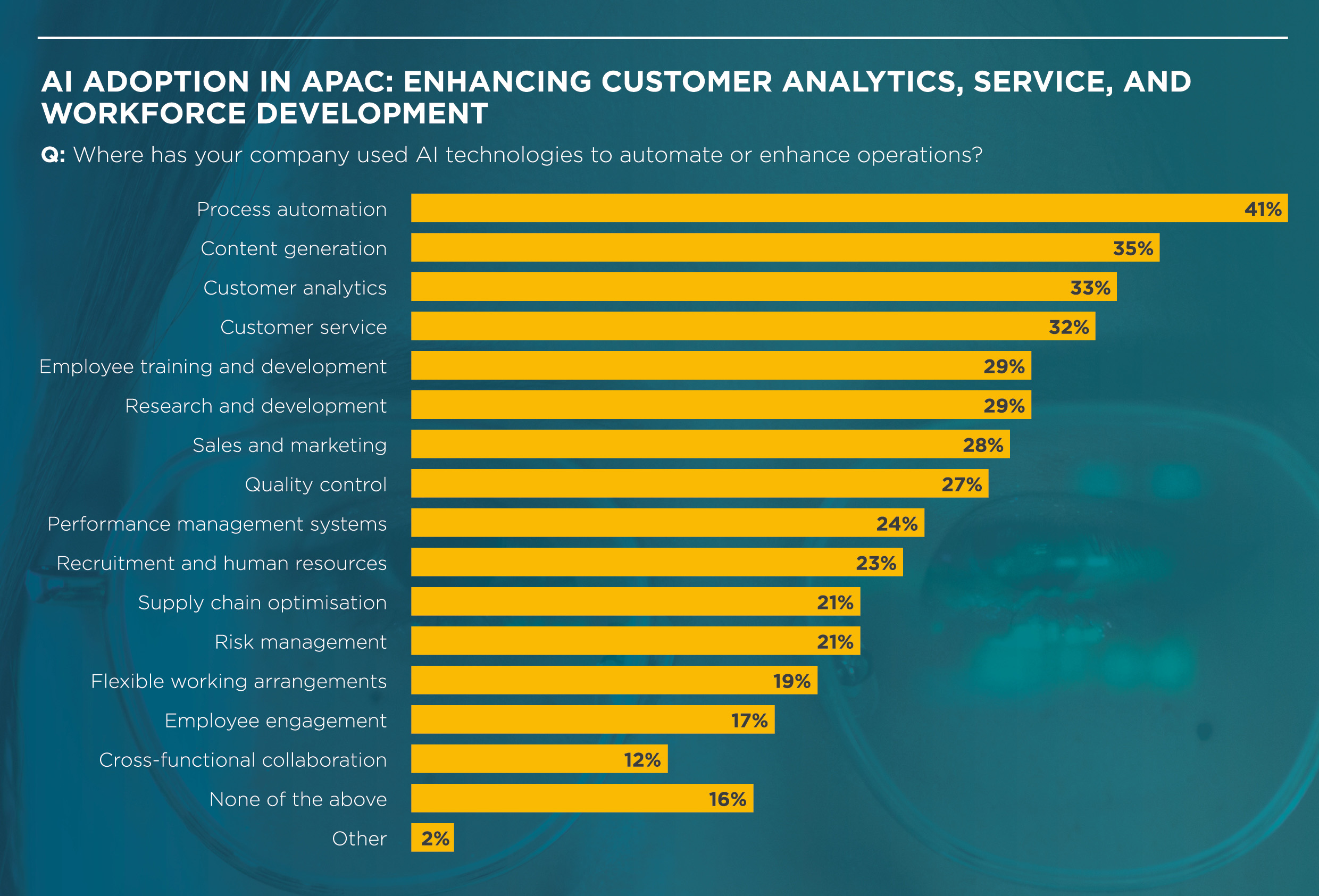Asia-Pacific: Navigating new digital frontiers for sustainable growth
HLB Survey of Business Leaders 2025APAC leaders have a favourable outlook for 2025. In most economies, inflation is de-accelerating, interest rates — easing, and consumer spending — climbing. 42% of leaders expect global growth to increase, up 5% from last year.
The International Monetary Fund (IMF) forecasts a 4.4% cumulative GDP growth in the region. India had a remarkable real GDP growth of 8.2% in 2024 and aims for 6.4% in 2025. Singapore’s economy expanded by 5% YoY and expects 1%-3% growth through 2025. Australia and Japan are on track to recover their GDP growth to 1%. Concerns over inflation are down by 12 percentage points from 2024. APAC interest rates are past the peak, with most central banks planning rate cuts this year.
Encouraged by macroeconomic developments, 79% of leaders are confident in their ability to grow revenue this year. The share of ‘very confident’ respondents increased by 1.3X compared to last year.

Still, several suppressors may impact business growth. China’s companies face profit margin squeezes due to weak domestic consumption and higher resource costs.
The government has responded with targeted consumer trade-in programs to boost spending through 2024 and 2025. However, the intensifying US-China competition, aggravated by bilateral tariffs, can negatively affect regional and global growth.
“China’s economy relies on three engines — exports, domestic consumption, and government investment,” explains Victor Tu, HLB China. “Given the current scenarios of export growth and consumer spending, the government will likely have to introduce new fiscal stimulus to meet the GDP growth target of 5%. However, such measures may still not fully improve business and consumer confidence.”
In response to domestic challenges, China’s companies double-down on overseas expansion, according to Victor Tu. Many aren’t just seeking new commodity markets but opportunities to create global supply chains, internationalise their brands and diversify risk exposures.
Thailand’s investor-friendly policies and qualified labour force have attracted a number of China’s businesses. Over the past two years, automotive BYD, Neta, Great Wall Motor, and Changan have built electric vehicle manufacturing facilities in the country.
Leaders remain cautious about possible fiscal, trade, and political developments, but most are committed to growth. To improve performance this year, businesses are focusing on three core imperatives: boosting operating efficiency, accelerating innovation, and future-proofing talent management.
Optimising business performance
Prolonged market uncertainty and an expanded risk radar compel leaders to become more agile. “The overall market sentiment is affecting many companies’ revenues and costs, so many are trying to squeeze more efficiency and improvements across the board”, observes Josh Chye, HLB Mann Judd. Higher interest rates and ongoing CAPEX investments in new facilities, products, and digital technologies have reduced many businesses free operating cash flow.
Improving operating efficiency is the top-most priority for 69% of APAC leaders. Cost reduction comes second at 55%.
66% of APAC leaders admit their business model needs improvement. The top-cited weaknesses are operating effectiveness, cost management, talent acquisition, and risk management.
Labour productivity in the region is uneven. APAC financial services companies, for example, have 4X higher productivity than manufacturing and twice that of business services providers. Regional manufacturers often struggle to balance quality and growth while increasing global competitiveness through innovation.
APAC leaders need to change their operating models for greater efficiencies and growth. Over 40% plan to streamline processes, strengthen risk management, enhance data analytics, upgrade technology systems, and improve business agility to optimise their operating model. To achieve these objectives, APAC leaders increasingly rely on digital technologies.

AI-driven innovation
APAC companies are convinced of AI’s strong impact. Three-quarters view AI as the top-most important technology for their business over the next five years. Moreover, 42% are already either widely using AI in their operations or proactively allocate resources for its implementation.
Regional AI leaders are emerging. China’s DeepSeek model gained global attention in January with its strong reasoning, surprising other generative AI models like GPT-4, Claude, and Gemini.
Despite being trained on a smaller data corpus and with less computing power, it matched Open AI’s latest o1 model performance. SenseTime has become a regional leader in deep learning and computer vision solutions for autonomous driving and smart cities. AI Singapore SEA-LION is a generative AI model that performs better in 11 regional languages.
“AI has come at a very fast pace to certain industries in India,” says Surabhi Bansal, HLB India. “Banks and telecoms are increasingly using AI, and you can feel that change in day-to-day life”.
Compared to global peers, primarily using AI for content generation, process optimisation, sales, and marketing, APAC leaders are also actively deploying algorithms for customer analytics, customer service, employee training, and R&D activity.
Favourable regulations fuel regional digital innovation, while younger demographics accelerate its diffusion. Singapore has a National AI Program for government, healthcare, and finance sectors. IndiaAI mission, launched in March 2024 with a budget of $1.3 billion over five years, includes initiatives across compute, foundational models, datasets, skilling, and trustworthy AI.

A sound 30% of APAC leaders see their innovation efforts as successful, increasing to 55% among companies, whose profits increased by 5% or more over the last year.
While investments in new technologies undeniably play a major role in innovation, leaders also seek to optimise important cultural components. A culture of innovation emerges at the overlap of four dimensions: Technology, processes, people, and data. APAC leaders have already made significant progress in modernising their infrastructure and process flows. Now they appear to focus on the last two dimensions: People and Data.
Re-thinking talent management
The rapid adoption of technology has transformed operating models. However, leaders now face the need to align these advancements with their human capital strategies. Over half (52%) view investment in people as an important lever for business growth, an impressive increase of 16% from last year.
Similar to other regions, APAC has been experiencing major labour market shifts. Countries like Japan, South Korea, and more recently — China, face labour shortages due to an ageing population. Meanwhile, other economies like India, Indonesia, and the Philippines have large youthful populations, but there is often a mismatch between open roles and available skill sets.
The labour disparities can be further aggravated by new technology adoption. 86% of APAC leaders believe their workforce won’t be able to adapt once their jobs are eliminated or changed by AI.
Workforce engagement and productivity have also been an issue. Only 33% of APAC leaders ranked their people as ‘high-performing and engaged’, with the majority (60%) saying they’re ‘mostly productive, depending on the circumstances’.
At present, many APAC companies struggle to align the new roles with the required skills. Lack of clarity and over-reliance on outdated role descriptions creates internal skills mismatches — discrepancies between the competencies required for a role and the employee's abilities. 57% of leaders aim to address this with targeted learning and development (L&D) initiatives to encourage continuous learning.
Maximising profit growth
Profit Accelerators aren’t limited to one industry. They include companies from the tech, financial services, manufacturing, transportation, and business services sectors, among others, generating anywhere between USD $26 million to over USD $500 million in annual revenue.
Profit Accelerators are 1.6X more likely to have a high-performing and engaged workforce, are 2.5X more likely to have an optimised operating model, and are 1.4X more committed to encouraging cross-functional collaboration and analysing customer behaviour data.
30% of surveyed businesses managed to increase their profits by 5% or more over the last year — the largest proportion of all regions in our global sample. Discover the strategic secrets behind maximising profit margins; download our in-depth report
Related content

Learn more about our research






